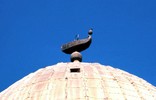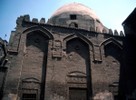Previous Lecture | Next Lecture
Concepts
The Sunnis: from sunna (tradition or custom), are those who adhere to the standard practice (understood to be of the Prophet). Sunnis are the majority of Muslims and follow four schools of jurisprudence: the Shafi`i, Hanafi, Maliki, and Hanbali. They accept the legitimacy of both the Umayyads and Abbasids. The Ayyubids vigorously promoted the Sunni revival in Egypt both to satisfy the demand of their power-base and to eradicate the traces of their Shi`ite Fatimid predecessors
Madrasa: An institution of learning that appeared in Khurasan in the 10th c. and spread all over the Islamic world. It was adopted by the Seljuqs to promote higher religious education. Madrasas usually follow an Iwan-based plan and they contain a mosque, classrooms, and lodgings for students and teachers.
The Qubba of Imam al-Shafi`i: Built by Sultan al-Kamil in 1211 over the tomb of this most eminent of Sunni jurists and founder of the Shafi`i school of law.
The Madrasa of Sultan al-Kamil: Built by Sultan al-Kamil in 1225 in the northern section of the Fatimid Western Palace, it comprised two iwans and probably some students cells.
The Madrasas of Sultan al-Salih Najm al-Din Ayyub: (1243) First madrasa in Cairo to accommodate the four schools of law. Built in the heart of the Fatimid city, it was composed of two separate, self-contained courtyard units, parallel in plan, separated by a passage, and having each two large iwans . Maqrizi calls them the two madrasas, and specifies that each iwan was allotted to one of the four school of Sunni jurisprudence. A mausoleum for the founder was added shortly after the completion of the complex by Shajar al-Durr, his wife.
The Qubba of Shajar al-Durr: (1250) Built by Shajar al-Durr with attached charitable institutions near the mausolea of a number of `Alid women saints.
The Roda Citadel: Now vanished, was built by al-Salih Najm al-Din Ayyub between 1240 and 1243 in Misr Island (known today as Roda Island), opposite the city of Misr al-Fustat. In it he housed his family and servants, and his select mamluks (estimated at one thousand), who became known as the Bahri mamluks (from the citadel's name, Qal'at al-Bahr, for bahr, sea in Arabic, is the name for the Nile in Egyptian dialect).
The Iwan of al-Salih at the Roda Citadel: Documented in the early nineteenth century, it comprised two iwans facing one another across a huge durqa`a. Four sets of columns formed a smaller rectangle inside the durqa`a which may have supported a dome. This plan may have formed a transitional stage between the majlis plan in Fustat houses, and the later qa`as of the Bahri Mamluk period.
Monuments






